Tag Archives: KBOA
Sad T-Shirts
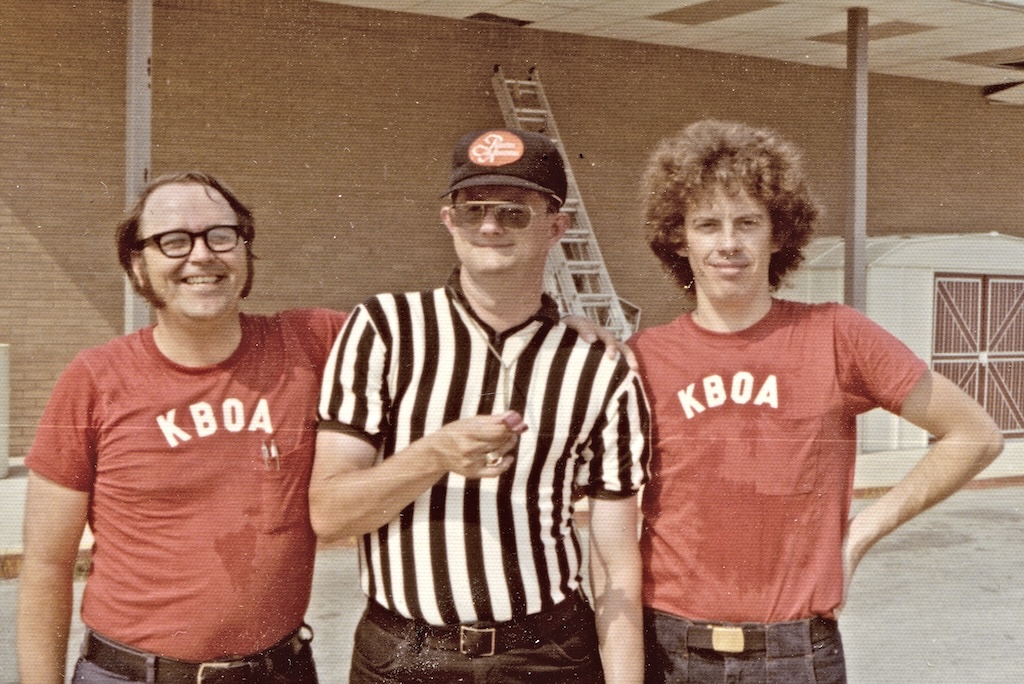
Came across this photo while cleaning out my office closet. First thought was, “Those are the saddest promotional T-shirts I’ve ever seen.” (I had almost no budget). My second thought was, “Looks like a scene from a remake of Napoleon Dynamite.”
AM radio is being removed from many cars
Following are excerpts from a story in The Washington Post:
Ford, BMW, Volkswagen, Tesla and other automakers are eliminating AM radio from some new vehicles, stirring protests against the loss of a medium that has shaped American life for a century. […] Automakers, such as BMW, Volkswagen, Mazda and Tesla, are removing AM radios from new electric vehicles because electric engines can interfere with the sound of AM stations. And Ford, one of the nation’s top-three auto sellers, is taking a bigger step, eliminating AM from all of its vehicles, electric or gas-operated.
Some station owners and advertisers contend that losing access to the car dashboard will indeed be a death blow to many of the nation’s 4,185 AM stations. […] From the 1950s into the 1970s, Top 40 hit music stations in many big cities maintained astonishing shares of the audience, with 50 percent and more of listeners tuned to a single station. […] Ford says its data, pulled from internet-connected vehicles, shows that less than 5 percent of in-car listening is to AM stations.
Of the $11 billion in advertising revenue that radio pulled in last year, about $2 billion came into AM stations, according to BIA Advisory Services, which conducts research for broadcasters.
Some of the best years of my life were spent in and around radio. But I haven’t listened in years. The Land Rover doesn’t have a radio and the pickup truck has one but it’s never worked.
It wouldn’t be much of an exaggeration to say that radio –in one form or another– paid for every stitch of clothing I ever wore and every bite of food I ate. But it changed and I changed. I suspect FM radio will disappear some day.
Charlie Earls 1938-2022
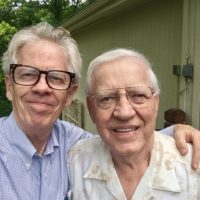 Charlie Earls didn’t give me my first job but he gave me the first job I really loved and, looking back 50 years, the best job I ever had. And he was a good man to work for.
Charlie Earls didn’t give me my first job but he gave me the first job I really loved and, looking back 50 years, the best job I ever had. And he was a good man to work for.
My father worked at KBOA or many years (so I was pretty much a legacy hire) and when my mom’s health went bad, Charlie let my dad have time off for trips to he hospital in Memphis and made his life easier in other ways.
As program director I would occasionally go to Charlie (owner/manager) for advice. He’d listen to my problem and then say something along the lines of: “Okay. I can tell you what you should do, but if I do… you have to take my advice. Do you still want it?” He understood it was better for me to make the call, even if I made the wrong one.
I was fortunate to know Charlie and to have worked for him.
(From Missouri Broadcasters Association Hall of Fame) “Charles Earls was born in Wyatt, Missouri, the youngest of 7 children. He attended elementary school in St. Louis, and graduated in Steele, Missouri in 1956. He was an Air Force control tower operator in Chitose, Japan, where he developed his love for radio. He was also a local disc jockey on the Air Force radio station.”
“His first paid job in radio was for Harold Sudbury, Sr. at KLCN in Blytheville, Arkansas in 1960. That’s where he met and married Scottie Jolliff. A son, Charles Scott was born in 1961. With a new family, Charles decided to make radio his career and answered an ad in Broadcasting Magazine for a job in Waco, Texas. KAWA was a 10,000 watt daytime AM station where Charles was hired as a salesman and weekend newsman. Within six months he was the manager. An Illinois newspaper company owned the station and Earls moved his family to La Salle/Peru, Illinois, to put a new FM station on the air for them. He worked on the newspaper side as a salesperson for a while until he was able to fulfill his dream of owning his own radio station by purchasing KTHS in Berryville, Arkansas.”
“The Earls moved to Berryville in 1966 and Charles started attending the Arkansas Broadcasters Association meetings. Later that year, KBOA & KTMO in Kennett, Missouri became available, and in October, the Earls’ bought those stations and moved to Kennett, while still managing KTHS.”
“In the coming years, they added Missouri stations in Farmington, Branson and West Plains, a station in Creston, Iowa, as well as Arkansas stations in Mountain Home and Yellville.”
Two old radio guys reminiscing
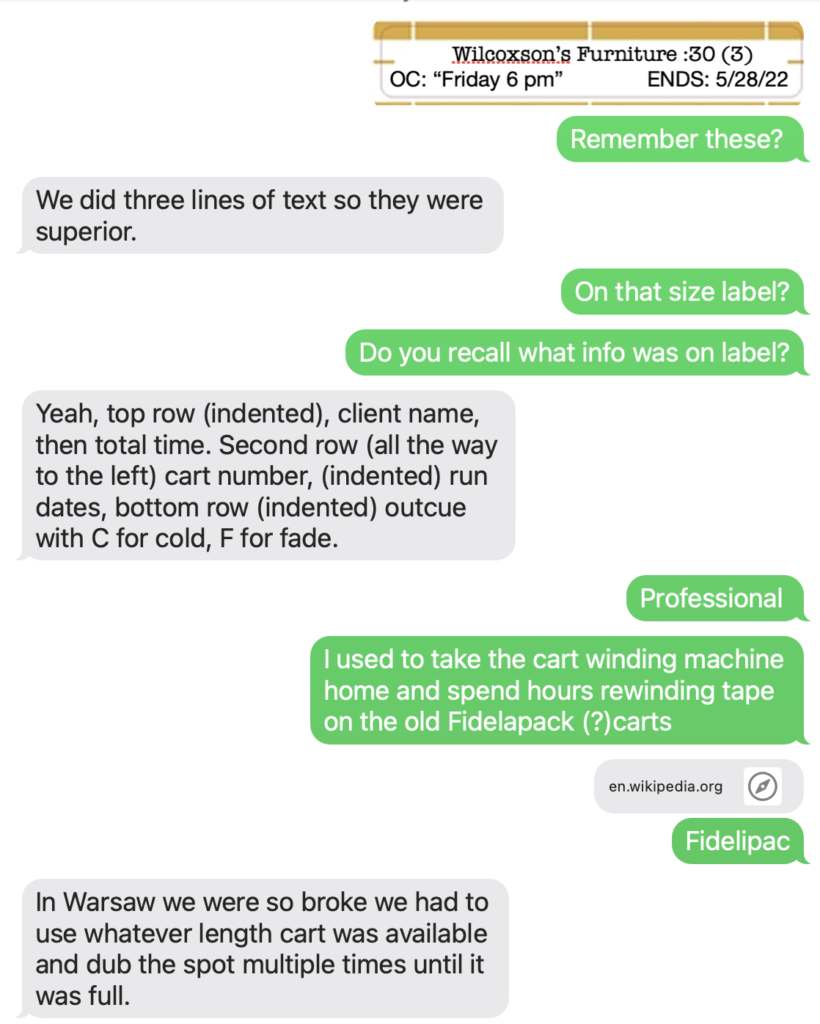
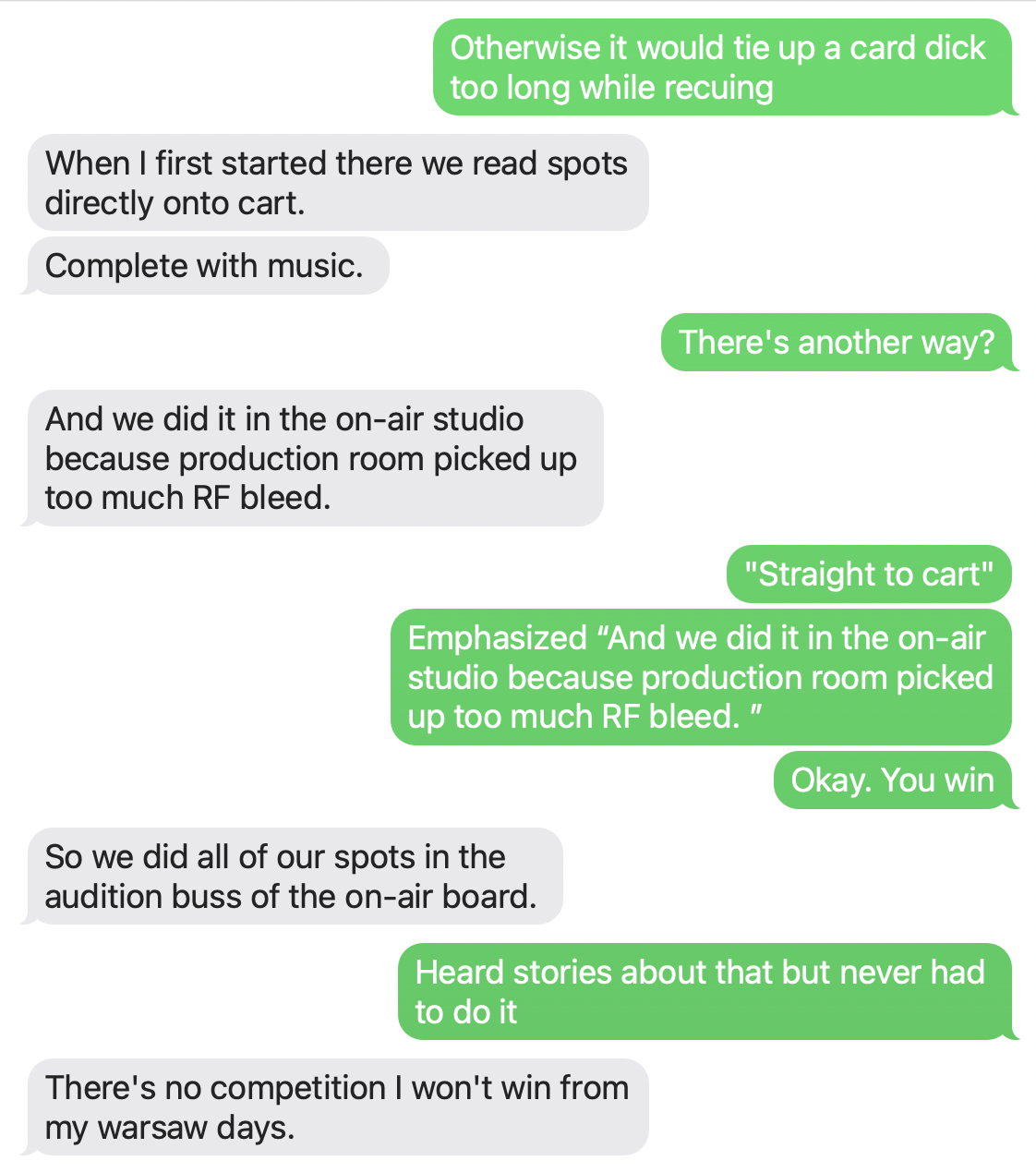
“Card dick” was my phones best guess at “cart deck.”
Did Buddy Emmons perform at KBOA?
According to Wikipedia, Buddy Gene Emmons (January 27, 1937 – July 21, 2015) “was an American musician who is widely regarded as the world’s foremost pedal steel guitarist of his day. He was inducted into the Steel Guitar Hall of Fame in 1981. Affectionately known by the nickname “Big E”, Emmons’ primary genre was American country music, but he also performed jazz and Western swing. He recorded with Linda Ronstadt, Gram Parsons, The Everly Brothers, The Carpenters, Roger Miller, Ernest Tubb, John Hartford, Little Jimmy Dickens, Ray Price, Judy Collins, George Strait, John Sebastian, and Ray Charles and was a widely sought session musician in Nashville and Los Angeles.”
According to a newspaper clipping (Calumet, Illinois) sent to me recently by Brandon Rowe, Emmons performed with one (or more?) bands that made regular “appearances” on KBOA during the early 1950’s.
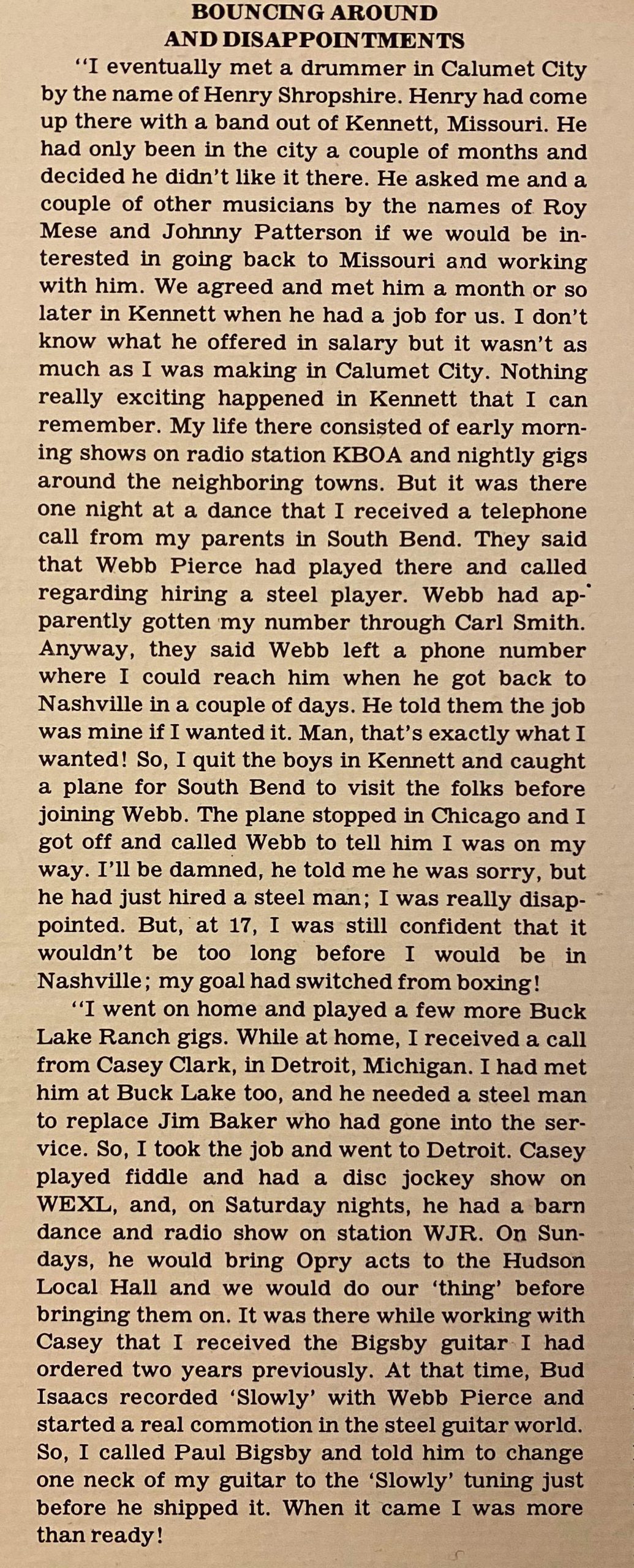
PS: My favorite line from the article: “Nothing really exciting happened in Kennett that I can remember.”
Reel-to-reel
Got a nice jolt of nostalgia from this flickr photo of a reel-to-reel tape. Particularly the reference to speed (7.5 ips = inches per second). The on-air studio at KBOA had a portable Ampex reel-to-reel tape recorder wired into the board and one of the requisite skills was “cueing up” a tape while reading the weather or news or whatever.
 “Originally, this format (reel-to-reel) had no name, since all forms of magnetic tape recorders used it. The name arose only with the need to distinguish it from the several kinds of tape cartridges or cassettes such as the endless loop cartridge developed for radio station commercials and spot announcements in 1954, the full size cassette, developed by RCA in 1958 for home use, as well as the compact cassette developed by Philips in 1962, originally for dictation.” – Wikipedia
“Originally, this format (reel-to-reel) had no name, since all forms of magnetic tape recorders used it. The name arose only with the need to distinguish it from the several kinds of tape cartridges or cassettes such as the endless loop cartridge developed for radio station commercials and spot announcements in 1954, the full size cassette, developed by RCA in 1958 for home use, as well as the compact cassette developed by Philips in 1962, originally for dictation.” – Wikipedia
Advertising
“With advertising revenue being the significant contributor to Facebook’s success, the risk for Facebook lies in the possibility that users will get bored of its properties – or of its ads,” Littleton said.
Advertising has been a part of my life for as long as I can remember. My dad was in radio for 30+ years and I was in or around it for 40. And advertising paid the bills. In 1971 I was road-tripping across the country with a friend when the radio station we were listening to broke for a commercial. I remember thinking, “I could write a radio commercial.” A year later I started working at a small town station and —over the next dozen years— wrote and produced a shit load of commercials. In the 70s, in our little town, you could advertise in the daily newspaper, on the radio, or you could rent a billboard.
In the late 40’s and 50’s, small town radio was such a new thing that listeners were happy to listen to anything on the radio. Music, news, commercials… how cool is that?! Joe Bankhead tells this story well.
Did any/all of those ads “work?” Were they effective? Not sure I thought about it at the time. If we wanted to keep the station on the air, we had to sell ads. I’ve thought about advertising a lot in the ensuing years. We pointed out to advertisers that our ads were “intrusive.” A good thing. Before they could hear the next song or the rest of the newscast, they had to listen to the commercial(s).
Somewhere along the way music radio stations came up with the idea of “stop sets.” Instead of mixing “spots” in with the songs, they’d stop twice an hour and play as many as eight commercials in a row. Advertisers would pay a premium to be the first, or the last, in the set.
In those days a radio spot was either “price and item” or “image.” Those of us who wrote and produced the spots liked to do image ads because it gave us creative freedom. Small market radio guru Jerrell Shepherd insisted all spots on his stations be price-and-item because it was the only way the advertiser could know his ads were working. Someone would come in and ask about the lawnmower sale he heard on the radio.
Any time an advertiser would question whether or not the ads were working, we’d explain they were “branding” his business in the (subconscious) minds of listeners.
In traditional media (radio, TV, print) it was pretty easy to tell what was a commercial and what was programming/content. When the internet came along someone figured out it might be useful to make a paid commercial message look like the content on the page. Finally we knew for certain: people hated ads. They installed software to block them. They used their DVR’s to skip them.
Today, the best advertising doesn’t really look like advertising. I think Amazon has probably perfected the art. An Amazon product page includes images of the product; reviews; and recommendations of similar products in which you might be interested. And if you don’t like something you bought, no problem. Easy returns.
I’ll admit to being a little amazed anyone keeps buying ads. They must believe they work. And it’s difficult to imagine our “consumer economy” working without advertising. Despite my life-long dependence, I am advertising averse. It’s like your next door neighbors inviting you over for drinks only to spring an Amway pitch on you. Or that Jehovah’s Witness who interrupts your nap with a fistful of Watchtowers.
Country vs. Pop
In one of the episodes of Ken Burns’ series on the history of country music, they trace the shift from country to pop music. I believe it was in the early 50’s. My father, John Mays, would have been at KBOA for several years by then and he had a better feel (and preference) for pop than country so he played that music while other announcers played different types. Rudy Pylant (Mr. Rudy) was known for Old Camp Meetin’ Time which was country gospel and “old time” music. Jimmy Haggett was — during this period — known as the country DJ.
The photo below was the result of a “popularity” contest in which listeners voted with 3-cent postcards.
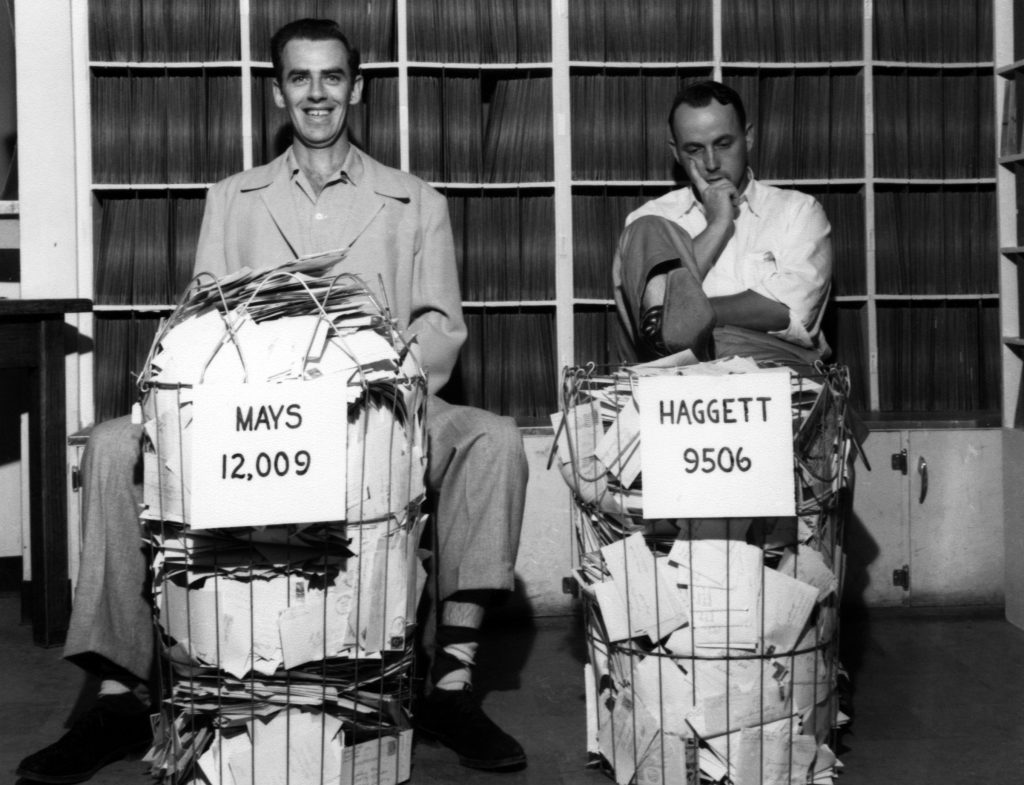
This must have been an incredibly exciting time to be in radio, even at a small market station like KBOA. Nashville station WSM (home of the Grand Ole Opry) was featured prominently in the Burns documentary Haggett worked there at some point after leaving KBOA.

